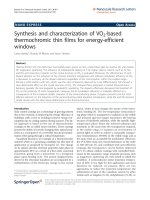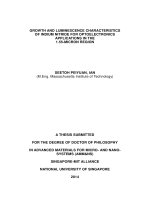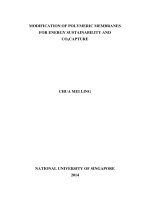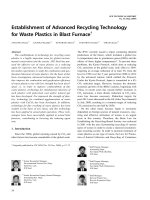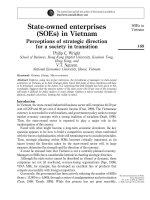Overview of recent technology for energy efficient in lighting in textiles
Bạn đang xem bản rút gọn của tài liệu. Xem và tải ngay bản đầy đủ của tài liệu tại đây (2.12 MB, 54 trang )
Overview of Recent Technology
Trends in Energy-Efficient Lighting
N. Narendran, Ph.D.
Lighting Research Centre
Rensselaer Polytechnic Institute
Troy, NY 12180 – USA
April 27-28, 2009
©
©
2009 Rensselaer Polytechnic Institute. All rights reserved.
2009 Rensselaer Polytechnic Institute. All rights reserved.
2
Acknowledgments
USAID/SARI/PA Consulting
SLSEA
LRC faculty, staff, and students
LRC program and project sponsors
©
©
2009 Rensselaer Polytechnic Institute. All rights reserved.
2009 Rensselaer Polytechnic Institute. All rights reserved.
3
Electric lighting history
In 1879, Thomas Alva
Edison demonstrated
the first successful light
bulb.
Over the past 125 years,
incandescent and gas discharge
technologies have provided many
shapes and sizes of light sources
for a variety of lighting
applications.
©
©
2009 Rensselaer Polytechnic Institute. All rights reserved.
2009 Rensselaer Polytechnic Institute. All rights reserved.
4
Light source technologies
0.0
0.2
0.4
0.6
0.8
1.0
1.2
350 450 550 650 750
Wavelength(nm)
Relative Energy
0.0
0.2
0.4
0.6
0.8
1.0
1.2
350 450 550 650 750
Wavelength(nm)
Relative Energy
Incandescent
Fluorescent
0
1
2
3
4
5
6
350 450 550 650 750
Wavelength(nm)
Relative energy
High Pressure
Sodium
Spectral power
distribution (SPD)
my.dteenergy.com/products/images/roadway1.jpg
©
©
2009 Rensselaer Polytechnic Institute. All rights reserved.
2009 Rensselaer Polytechnic Institute. All rights reserved.
5
0.0
0.2
0.4
0.6
0.8
1.0
350 400 450 500 550 600 650 700 750
Wavelength(nm)
Relative Energy
Luminous flux and efficacy
Lumen and lumens per watt are two key
metrics commonly used in the lighting
industry to quantify performance of light
sources.
Lumen: The luminous flux accounts for
the sensitivity of the eye by weighting the
radiant power at each wavelength with
the human eye response function.
Lumens per watt: Luminous efficacy of a
light source is the total luminous flux
emitted by the lamp divided by the total
lamp power (electrical) input.
Flux (Φ) = 683 ∫ S
λ
V
λ
dλ (lm)
Efficacy = Φ / W (lm/W)
©
©
2009 Rensselaer Polytechnic Institute. All rights reserved.
2009 Rensselaer Polytechnic Institute. All rights reserved.
6
6
Light source technologies
Incandescent and halogen light
sources range in efficacy from 2
to 30 lm/W.
Fluorescent light sources range in
efficacy from 25 to 105 lm/W.
High-intensity light sources range
in efficacy from 25 to 150 lm/W.
©
©
2009 Rensselaer Polytechnic Institute. All rights reserved.
2009 Rensselaer Polytechnic Institute. All rights reserved.
7
Incandescent
Filament heating produces light
¾ Only 5% of the total energy input is
converted to light and the rest is heat
¾ Very inefficient
Efficacy
¾ Generally around 15 lm/W
Color
¾ CRI = 95+
¾ CCT = 2500K – 3000K
Life (average rated)
¾ 750 – 2000 hours
¾ Dimming can extend life
©
©
2009 Rensselaer Polytechnic Institute. All rights reserved.
2009 Rensselaer Polytechnic Institute. All rights reserved.
8
Halogen
A halogen lamp contains an inert gas
and a small amount of halogen.
Efficacy
¾ PAR and MR Lamps (line or low
voltage)
9 10 to 25 lm/W
¾ IR PAR Lamps (Infrared reflector)
9 20 to 30 lm/W
Color
¾ CRI – 95+
¾ CCT – Typically 3000K
Life (average rated)
¾ 2000 hours
¾ Shortens if consistently dimmed below
80%
©
©
2009 Rensselaer Polytechnic Institute. All rights reserved.
2009 Rensselaer Polytechnic Institute. All rights reserved.
9
9
Fluorescent
A fluorescent lamp is a low-intensity gas-discharge lamp
that uses electricity to excite mercury vapor to produce
ultraviolet (UV) radiation that causes a phosphor to
fluoresce and produce light.
¾ Linear fluorescent lamps (LFL) and compact fluorescent lamps
(CFL) are popular choices for conserving energy.
¾ About 20% to 30% of the total energy input is converted to light.
©
©
2009 Rensselaer Polytechnic Institute. All rights reserved.
2009 Rensselaer Polytechnic Institute. All rights reserved.
10
Compact fluorescent lamp (CFL)
Types:
¾ Pin-base for dedicated fixtures
¾ Screw-base self-ballasted
Efficacy:
¾ 25 to 60 lm/W
Color
¾ CRI = 82 typical
¾ CCT = 2700K, 3000K, 3500K,
4100K, 5000K
Life
¾ 6,000 to 10,000 hours
9 Frequent on-off switching can
reduce life significantly
9 Dimming is possible but can
reduce life
Ö
©
©
2009 Rensselaer Polytechnic Institute. All rights reserved.
2009 Rensselaer Polytechnic Institute. All rights reserved.
11
Linear fluorescent lamp (LFL)
Lamp Efficacy
¾ Ranges from 65 to 105 lm/W
Color
¾ CRI = 82 typical
¾ CCT = 2700K to 5000K
Life
¾ 20,000 to 30,000 hours
9 Frequent on-off switching can
reduce life significantly
9 Dimming can reduce life
©
©
2009 Rensselaer Polytechnic Institute. All rights reserved.
2009 Rensselaer Polytechnic Institute. All rights reserved.
12
Ballasts for LFL
Fluorescent lamps require a
ballast to operate
¾ Magnetic
9 Low frequency (60 Hz) operation
9 May produce audible hum
9 May produce noticeable lamp flicker
9 Inefficient lamp operation
¾ Electronic
9 High frequency (20 to 60 kHz)
operation
9 Quiet
9 No noticeable lamp flicker
9 More efficient lamp operation
©
©
2009 Rensselaer Polytechnic Institute. All rights reserved.
2009 Rensselaer Polytechnic Institute. All rights reserved.
13
High intensity discharge (HID)
Metal halide lamps produce light by
passing an electric arc through a mixture
of gases, which causes a metallic vapor to
produce radiant energy.
¾ It contains a high-pressure mixture of argon,
mercury, and a variety of metal halides in a
compact arc tube.
¾ About 24% of the total energy input is
converted to light.
Three types of HID lamps:
¾ Mercury vapor lamp
¾ Metal halide lamps
¾ High-pressure sodium (HPS) lamp
www.holophane.com
©
©
2009 Rensselaer Polytechnic Institute. All rights reserved.
2009 Rensselaer Polytechnic Institute. All rights reserved.
14
Ballasts for HID
Metal halide lamps require ballasts to
regulate the arc current flow and
deliver the proper voltage to the arc.
¾ Probe-start metal halide: Contains a
starting electrode within the lamp to
initiate the arc when the lamp is first lit.
¾ Pulse-start metal halide: No starting
electrode but has a special starting circuit
to generate a high-voltage pulse to the
operating electrodes.
©
©
2009 Rensselaer Polytechnic Institute. All rights reserved.
2009 Rensselaer Polytechnic Institute. All rights reserved.
15
Lighting controls
Manual controls
¾ Wall switch: on or off
¾ Dimmers
Automatic controls
¾ Time clocks
¾ Occupancy sensors
9 Infrared
9 Ultrasonic
9 Dual technology
¾ Panel relays
¾ Centralized controls
©
©
2009 Rensselaer Polytechnic Institute. All rights reserved.
2009 Rensselaer Polytechnic Institute. All rights reserved.
16
Efficacy and energy savings
Energy use depends on the connected load and
time of use
¾ Watt-hours
MYTH: High efficacy light sources always save
more energy than low efficacy light sources.
¾ Spatial – light not reaching the application area is
wasted light (energy)
¾ Temporal – light beyond the required time is wasted light
(energy)
©
©
2009 Rensselaer Polytechnic Institute. All rights reserved.
2009 Rensselaer Polytechnic Institute. All rights reserved.
17
Energy Conservation
©
©
2009 Rensselaer Polytechnic Institute. All rights reserved.
2009 Rensselaer Polytechnic Institute. All rights reserved.
18
Different forms of luminous efficacy
Light source (lamp) efficacy: Total lumens
out of the light source divided by the total
input power to the light source
Light source + ballast efficacy: Total
lumens out of the light source divided by the
total input power to the ballast
Luminaire efficacy: Total lumens exiting
the luminaire divided by the total input
power
©
©
2009 Rensselaer Polytechnic Institute. All rights reserved.
2009 Rensselaer Polytechnic Institute. All rights reserved.
19
Luminaire efficacy
In this example, the total luminaire efficiency is 33%
to 54%.
A 60 lm/W CFL would yield:
¾19 to 32 lm/W final system efficacy in these luminaires
¾IR Halogen PAR lamp would be a better choice than
combinations A to J
CFL
24W CFL Fixture
0%
20%
40%
60%
80%
100%
ABCDEFGH I JKL
Flux exiting the fixture
©
©
2009 Rensselaer Polytechnic Institute. All rights reserved.
2009 Rensselaer Polytechnic Institute. All rights reserved.
20
Application efficacy
Lighting Objective – Illuminating the picture on the wall
Application lumens: Total lumens reaching a picture area
Wasted lumens: Lumens beyond the area of the picture
Application
lumens
Wasted
lumens
©
©
2009 Rensselaer Polytechnic Institute. All rights reserved.
2009 Rensselaer Polytechnic Institute. All rights reserved.
21
0
10
20
30
40
50
60
Halogen F8T5
sample 1
F8T5
sample 2
LED
Sample 3
LED
Sample 4
Efficacy (lm/W)
Application Efficacy (lm/W) (Fixture + Driver) Efficacy (lm/W)
-12%
+32%
0
10
20
30
40
50
60
Halogen F8T5
sample 1
F8T5
sample 2
LED
Sample 3
LED
Sample 4
Efficacy (lm/W)
Application Efficacy (lm/W) (Fixture + Driver) Efficacy (lm/W)
-12%
+32%
Application efficacy
In this example, compared to sample 1, sample 3 is
designed better to direct the exiting lumens to the area
where it is needed.
©
©
2009 Rensselaer Polytechnic Institute. All rights reserved.
2009 Rensselaer Polytechnic Institute. All rights reserved.
22
Application efficacy
Not switching off the light at the right time wastes energy.
©
©
2009 Rensselaer Polytechnic Institute. All rights reserved.
2009 Rensselaer Polytechnic Institute. All rights reserved.
23
23
Environmental considerations
Mercury
¾ An essential component of many
energy-efficient light bulbs.
¾ Throwing these lamps into the garbage,
which ultimately end up in landfills, can
pollute the environment.
– /> Health Effects
¾ Mercury exposure at high levels can
harm the brain, heart, kidneys, lungs,
and immune system of people of all
ages.
– /> Lamp Disposal
¾ Programs that promote energy-efficient
technologies must also consider proper
disposal programs.
/>www.ci.st-joseph.mo.us/publicworks/CFL_Ad.jpg
©
©
2009 Rensselaer Polytechnic Institute. All rights reserved.
2009 Rensselaer Polytechnic Institute. All rights reserved.
24
Selecting Technologies
for Energy-efficient
Lighting Application
©
©
2009 Rensselaer Polytechnic Institute. All rights reserved.
2009 Rensselaer Polytechnic Institute. All rights reserved.
25
25
Lamps for residential applications
Today, linear and compact
fluorescent lamps can be used in
houses to conserve energy and
reduce nighttime power demand.
A variety of CCTs
available for the
different applications


